What Wikipedia Can’t Tell You About Saving on Heating Bills
12th Oct 2017

How To Save Money on Your Heating Bills - The Whole Story
Energy Consumption in The U.S.
According to ScienceDirect.com July 2014, Regional Science and Urban Economics, Volume 47 publication, U.S. housing is over 22% of the country's total energy consumption. This figure is equal to more than $2K per household and about $229 billion in total. As homes age, their energy usage becomes less efficient, meaning that they use more energy based on their time of construction. For example, homes built before 1950 are using more energy than homes built after 2000 – about 40% more!
Older homes as they are in their current condition is one of the main roadblocks our country faces when trying to decrease energy consumption. Most folks who reside in older homes don’t have the money they need to make energy efficient upgrades – which can cost thousands of dollars.
So, where is most of our energy consumed? Take a look at the list below, which shows that the majority of energy consumption is related to space heating, space cooling, and water heating.
|
How Energy's Consumed |
% Total Consumed |
|
Space Heating |
44.7% |
|
Water Heating |
16.4% |
|
Space Cooling |
9.2% |
|
Electronics/Computers |
6.2% |
|
Lighting |
5.9% |
|
Refrigeration |
3.9% |
|
Cooking |
3.7% |
|
Washers/Dryers |
3.3% |
|
Other |
6.7% |
Table Source: U.S. Energy Information Administration (2012)
Luckily, new homes built today are more efficient even though they are larger and often perceived as less economical. If you were to look at the types of homes such as single family, attached, multi-family, etc., these statistics indicate that again, newer, single family homes are more efficient than other forms of housing. See the chart below.
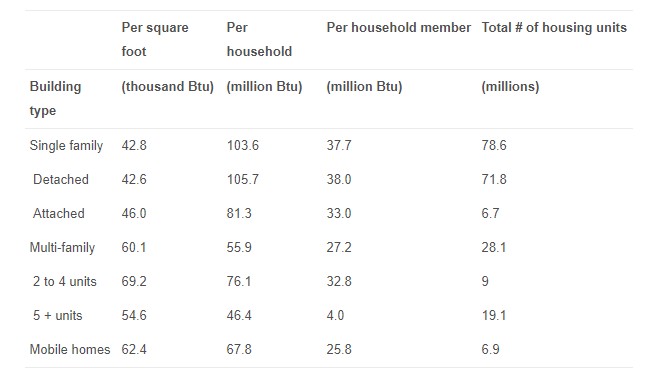 Source: EIA (2012), 2009 RECS Preliminary Consumption and Expenditure Tables.
Source: EIA (2012), 2009 RECS Preliminary Consumption and Expenditure Tables.
Not only are newer homes more energy efficient – they are also located in warmer areas of the country, as you can see in the following chart. As years have passed the trend is that more new homes are less likely to be in colder areas, which only adds to their efficiency.

Source: EIA.org
Another misconception about newer, larger homes is that the higher ceilings waste heat, however, because most newer homes contain double or triple paned windows they conserve heat. Take a look.
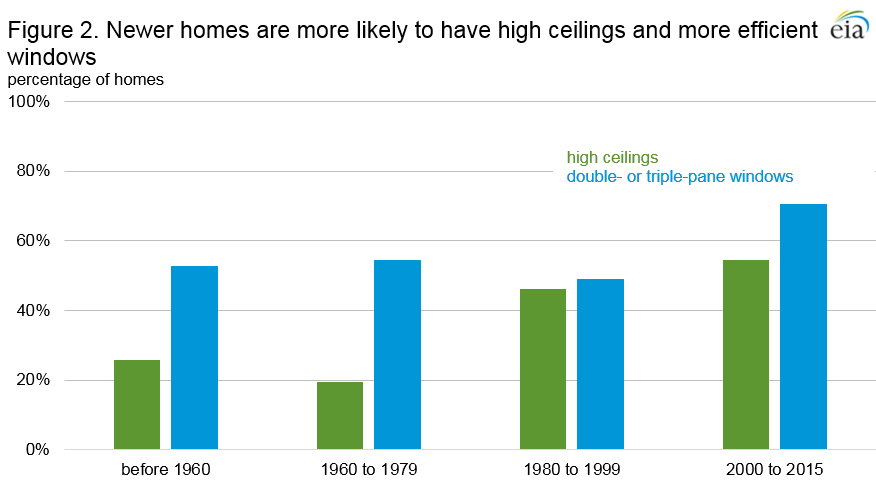
Source: EIA.org
Heat Uses and Types by Region
What we use or how we heat our homes is another thing to consider when educating ourselves how to conserve energy. American households typically use several types of energy. According to the U.S. Energy Information Administration (EIA), in 2015, 75% of U.S. households used more than one source of energy. 66% used electricity plus one other fuel, and 9% used three or more types of fuel. Single-family homes were the least likely to be all electric – about 18%, while mobile homes were the most likely at about 44%.
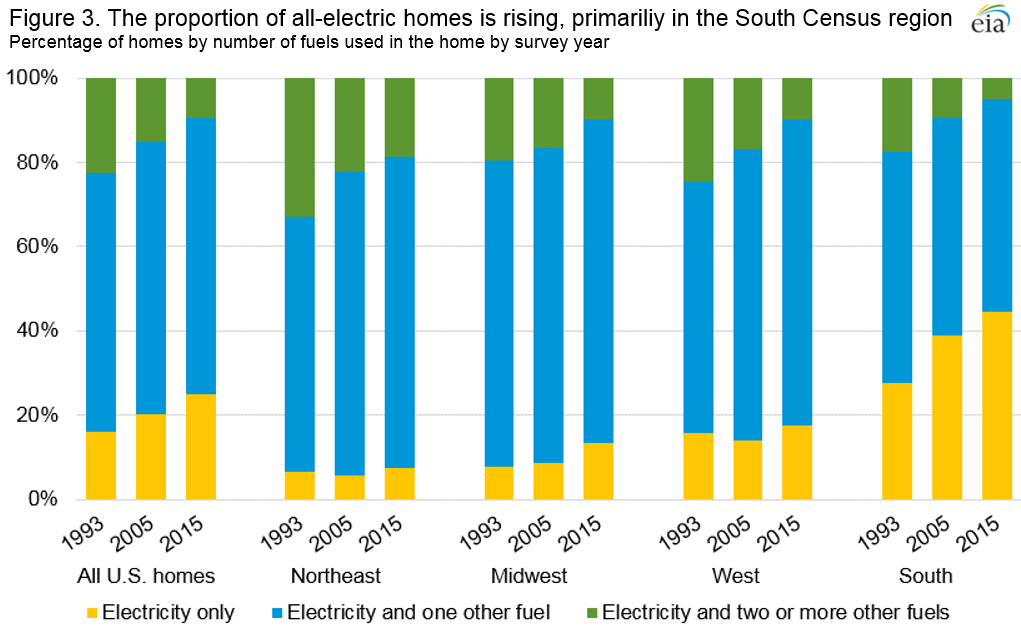
Source: EIA.org
In addition to the types of energy used in homes, the EIA 2015 RECS survey also questioned the central heating element being used by homeowners and non-homeowners. Take a look at the chart below; you will see the most common in the U.S. is central warm-air furnaces within single family homes. Whereas in apartment style homes, built-in electric units, steam or hot water systems that circulate through radiators were more widely used. Finally, it's no surprise that mobile homes make up the largest use of portable electric space heaters.

Source: EIA.org
So, how do Americans interact with their main heating elements – what are their behaviors? And, what other types of heat sources do they use most to heat their homes?
The most common action (about 40%) was to set one temperature within the home and leave it for the remainder of the day. Others made adjustments throughout the day depending on the temperature fluctuations. Out of these adjustments, 26% were made manually, while programming changes are at about 17%. Others turned their heat on and off to suit their comfort level during the day, which accounted for about 14% of heated homes.
Like we mentioned above many American homes use more than one heat source (about 38%). Looking at the chart below you can see that shockingly 47% of Americans use portable electric heaters as their secondary heat source.
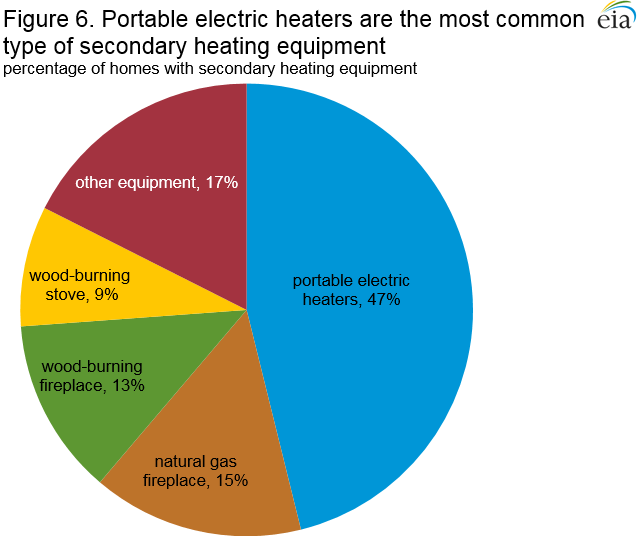
Source: EIA.org
How Does the U.S. Compare to the Rest of the World?
Overall, the energy consumption of the U.S. is less than half that of these same types of buildings in Western Europe and other developed countries, which leads us to believe that Americans are indeed practicing energy saving solutions – however, these statistics could be off-set because European residents have higher energy prices. This brings us to question whether Americans are trying to save energy and what energy saving tips have they uncovered.
The Basics of Heat Transfer: How does my body manage heat?
Before we get into what Americans are doing to save heat, let's first understand our bodies and how they obtain and sustain heat. Muscles and the metabolism in our bodies are always working, creating heat. Because of this, we need to disperse heat into the atmosphere by sweating, exhaling and circulating blood close to the surface of our skin for the cooling factor.
Our internal temperature works like this - when there is a large difference between our body temperature and the air, we're able to cool down very easily. But, when the air is the same temperature as our internal temperature it's harder for us to cool ourselves. Humidity makes things worse by basically suffocating our sweat, which is our body’s primary method of cooling itself.
On the other hand, extremely cold weather takes the heat from our bodies, and we can't keep up. Our internal temperature drops. However, there are a few ways the body can gain more heat. Below are two ways; the third we'll discuss later.
- Heat by Exercise – Physical activity (energy) produces heat. Exercise keeps muscles active, increases circulation improves digestion, and enables all parts of the body to work better together. Have you ever been told to do jumping jacks if you were cold? Now you know why.
- Heat by Food – Cells in the body burn food which produces heat and energy. Food is one source that produces heat for the body. Other things like the sun, warm air, even exercise just keep the cells active, so that heat forms. However, when you intake food it gives the body heat. Although, not all food creates heat.
Here are six foods that have scientifically been proven to create heat within the body and help to regulate your internal temperature. You're probably thinking "Ok, so soup, hot tea, spicy peppers, stuff like that – right?" Wrong. Check out our list:
- Heating Foods
- Iced Coffee – It's the caffeine that creates heat not the temperature.

- Lean Meats – These foods are rich in iron. Iron helps the body to warm up. Things like lean beef, poultry and pork tenderloin all contain the heat producing mineral.
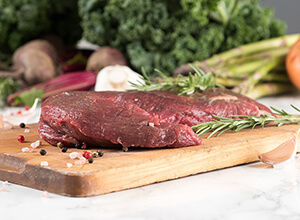
- Whole Grains and Complex Carbs – It's all about the fiber. These types of foods, like potatoes, lentils, etc. require more energy from the body to help break them down. The fiber that these foods contain not only keep the body fuller longer but also warmer.

- Cumin – Sorry hot peppers. Hot, spicy foods make the body sweat which helps to cool down the body. Scientists are not yet sure how cumin warms the body, but they do know that it does create heat just a less intense version of it.
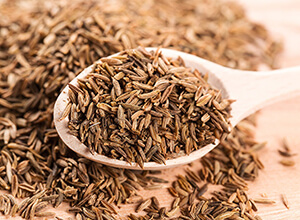
- Ginger – A 2012 study published by Metabolism discovered that the spice enhances thermogenesis, also known as heat production. Ginger is very versatile and great to add to many meals, from soups to tacos!

- Bananas – One banana contains about ten percent of the day's magnesium and B vitamins. These two nutritional powerhouses help the thyroid, and adrenal gland regulates the body's temperature when it's cold.

Why Is It Important to Practice Energy Saving Tips?
The third way to obtain heat that we mentioned above is; you guessed it – external heat! Furnaces, heat pumps, boilers, gas fired spaced heaters, electric space heaters, etc. These types of heaters require energy – some more efficient than others. Every category mentioned here has various products available, and all have different levels of how they produce energy, so there are plenty of options. However, the downside is… energy is not free.
Our power consumption these days is not only a cost concern but an environmental concern. Do you realize that every time you make a cup of coffee or watch TV, you are using the earth's finite resources? Fossil fuels are where our energy comes from, and there isn't an endless supply.
And, that's not all. Every time fossil fuels burn, CO2 releases into the atmosphere. CO2 affects the earth's climate and weather systems. Some can appreciate the long summers and hot weather, but other types of severe weather such as flooding, droughts, etc. are not so welcome.
This process of how we access energy is why it's so important to practice energy saving tips. Our fossil fuels that remain become more and more precious every second. Industry experts predict that current oil reserves will only last another 40 years and coal another 200 years. Also, carbon dioxide emissions have been rising because of gas prices increasing which mean more coal usage.
What's New in How We Save Energy?
Luckily, Americans' are starting to realize the issues with power consumption and the experts have begun to invent and develop better ways to for us to conserve and utilize energy. The U.S. Department of Energy has developed a national rating system known as The Home Energy Score. The score tells a homeowner if their home is efficient or inefficient based on a few things:
- Structure
- Heating system
- Cooling system
- Hot water system

Source: Energy.gov
The rating system also provides areas of improvement and how to save money.
If you're building a new home, consider energy efficient appliances and building materials, or if you live in an existing house get an energy audit performed. To learn more about the audits visit the U.S. Department of Energy article on Do-It-Yourself Home Energy Audits.

Other methods on how to conserve energy and lower your electric bills include:
- Cool roofs – Using reflective materials to absorb less heat when it's hot
- Earth sheltered homes – Build your home underground for comfort, durability, and efficiency
- Log homes – Construct a log cabin. Solid wood logs are excellent at maintaining energy efficiency
No Cost and Low-Cost Ways to Save Heat
Yes, there are actions you can take to salvage heat that doesn't cost you money. And, with heat taking up about 70% of our total energy usage you'll want to keep these ideas on hand once the cooler weather arrives. Here are a few to get you started:
- No Cost Ideas:
- Pull back the curtains and raise the blinds – On sunny days get some natural heat from the sunshine. Be sure and close them at night to keep the heat indoors.
- Filter maintenance – Clean your filters regularly to keep your furnace working efficiently.
- Use your vacuum - Clear any dust or debris from your registers and avoid blocking them with furniture or other things to maintain the air flowing.
- Turn it down – Turn down the thermostat during the day.
- Fireplace care – Close dampers when you are not using them.
- Layer up – Wear more layers of clothing and be sure to cover your feet and hands. If they're warm, chances are the rest of your body is comfortable.
- Say "No" to drafts – Make sure any draft areas are covered such as doorways, windows, etc. Use some old towels, sweatshirts, or bedding.
Maybe you've checked all the no cost savings off your "Save on Heat" checklist, and now you need to up your game. We've got plenty of ideas, and probably even some you may not have heard before. The good news is each one of these low-cost heat saving ideas can put an extra $500-$1,000 in your pocket each season.
- Low Cost Ideas:
- Cover your chimney – Did you know you could be letting precious heat escape from your chimney? Yes, it's true! Cap the top, or use an inflatable chimney balloon if you use your fireplace more regularly. Better yet, look into The Fireplace Heatsaver a transparent shield made of acrylic so you can enjoy your fire and still save heat. Cost: $40-and up.
- Dry some clothes – Use your clothes dryer and a nifty little invention known as the Dundas Jafine Heat Keeper. This cool little gadget lets you add extra heat to your home while you dry your clothes – it's like a two for one! It's super easy to install and you can use it in the summer to push warm air outdoors. The best part is the price. Cost: $7-$14.
- Insulation and more insulation – You can lose up to a quarter of your heat through an uninsulated roof. So it's important to be sure 1) Your roof is in fact insulated and 2) If it is insulated, consider adding another layer. Cost: Varies depending on what type of insulation you choose.
- Heat lamps – Portable heaters like heat lamps help to keep you warm in one particular space instead of heating an entire home or large room. Cost: $10-$20.
- Turn your ceiling fan on – Yes. You read that right. Using your ceiling fan in the fall or winter can be just as effective. Switch the direction of the fan, so the air blows up. This action pushes the warm air off the ceiling and bounces it back down. Don't have a ceiling fan? No problem. Use a standard box fan and run it at the highest speed pointing it upward towards the ceiling. Cost: $10-$15.
DIY Heat Saving Projects
Are you someone who likes a good project and enjoys the feeling of being productive? Well, you're in luck because not only can you save money with these next few ideas, but you can do them yourself!
- Got Flower Pots? – Turn your terracotta pots into a mini-heater. Take the base of a clay flower pot and place a candle in it. Turn the pot upside down hovering it above the candle and safely secure it onto a frame of some sort. The coolest part - You can find just about all of these supplies in your garage or at your local flea market.
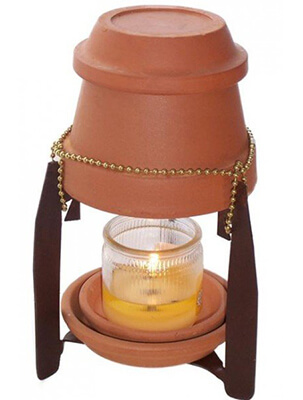
- Learn from the Japanese – Make a kotatsu. Trap warm air by taking a thick blanket or comforter and placing it over a table frame. Put your legs under the blanket and eat, drink, watch Netflix or get some work done on your laptop while you stay nice and toasty.
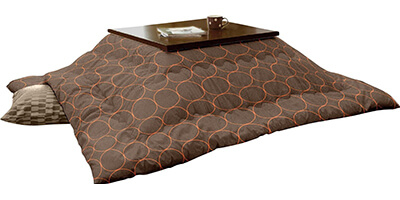
- Heated Rice Bags – All you need is an old sock or pillow case and rice! Fill one of these items with a few cups of rice and tie or sew the end off. Throw it in the microwave for a few seconds and use it on your lap, hold it in your hands, place it on top of your feet or around your neck.
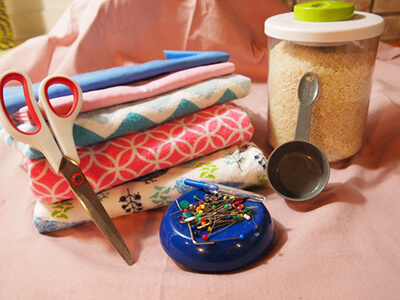
- Warmth by Snuggle Sack – Crochet or sew your very own snuggle sack. These body heat keepers are not just for hedgehogs and pups – they're for anyone. Use some old fabric, repurpose old towels, bedding or pick up some soft flannel material and get going.

Fall and Winter Energy Saving Ideas
Now that we've covered the main culprit of energy consumption let's talk about the bigger picture and look at some overall ways to save energy. When cooler temperatures start to roll in, most folks aren't thinking of what needs to be taken care of indoors, but rather they're thinking of what needs to be tended to outdoors.
From covering bushes, setting up a compost bin to clearing out gutters – there's a lot that goes into winter prep. However, it's a good idea to focus your attention indoors as well. Here are a few things to keep in mind.
- Check-up – Schedule a maintenance review for your furnace or primary heating source(s). Also, clean and replace the air filter.
- Drafty areas – Doorways, windows, fireplace – any spaces to the outdoors that exist in your home should be reviewed to see if extra insulation is needed to prevent heat loss.
- Remove air conditioners – If you're using window units to keep your home cool, be sure and take the time to remove them. Don't take the lazy way out and just try to cover them up with one of your inventions.
- Ducts, attics, basements, fireplace, crawl space, etc. – These types of exposing areas will suck the heat right out of your home so be sure and use a durable sealant to fill any of these regions.
- Upgrade your thermostat – If you have an older thermostat, replace it with a programmable one. You'll be able to program your heat to decrease and increase according to what time of day it is - saving you money.
- Reverse your fans – Ensure your ceiling fans are switched direction to push air up and so they can bounce warm air back down.
- Electric outlets – Place foam sheets behind the outlet plates to prevent any air sneaking out through those areas.
We could go on, but rest assured that these are some of the most important parts of the home to inspect where heat loss is prevalent. Want more? Download the Energy Saver Guide provided by Energy.gov.
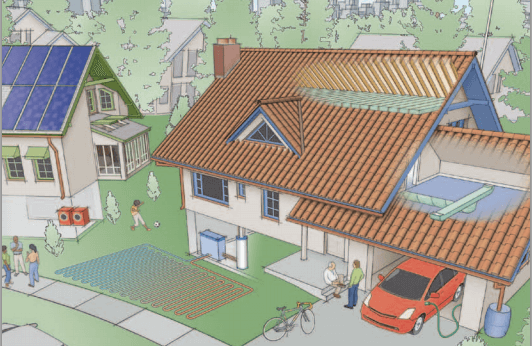
Source: Energy.gov
Conclusion
Thanks to the relevant sources of information on the internet (especially this article) it's easier than ever to put into practice ways to consume less energy. Not only that, but who doesn't want to put more money back into their pocket?
Saving on your heating costs and energy bills also works to protect the environment and preserve what fossil fuels we have left. All it takes is a little time, effort and appreciation for mother earth. And, don't forget to check out the Dundas Jafine Heat Keeper and related energy saving products. The Heat Keeper is the perfect tool to get you going and for keeping you extra warm this season.
